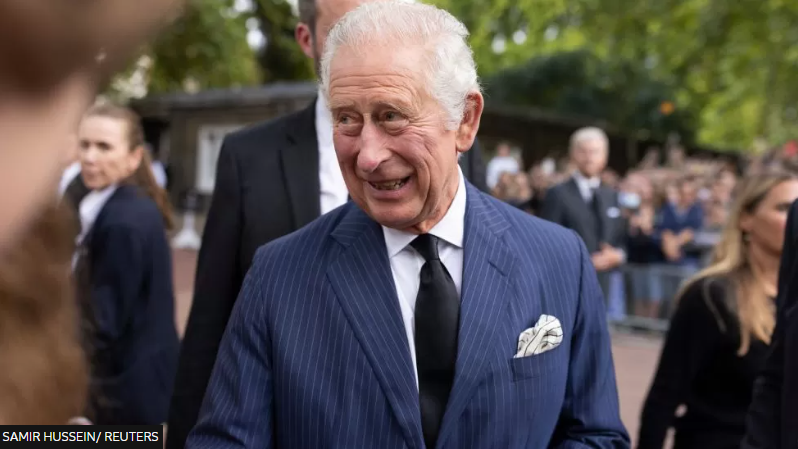Ian Cooper (DCU Brexit Institute)
Over the past year, the changing character of politics in Northern Ireland, as well as in the United Kingdom (UK) and its evolving relations with the European Union (EU), may be illustrated with reference to three occasions in the reign of the new monarch, King Charles III.
The first occasion came when the new king ascended the throne after the death of his mother, Queen Elizabeth II. Charles embarked upon a tour of the devolved regions of his kingdom, but his itinerary in this one part of his realm was disturbed by its lack of a functioning devolved government. In Scotland, he was ceremoniously welcomed by the First Minister in the Scottish Parliament, which passed a motion of condolence in honour of the late queen. A similar ceremony took place in Wales, where the king met the Welsh First Minister and received a motion of condolence from the Senedd Cymru. However, the same formalities were not were not possible when he visited Northern Ireland, because there was no sitting Stormont Assembly and the office of First Minister was unfilled.
The most recent elections to the Northern Ireland Assembly, in May 2022, had brought an upheaval to the politics of the region. For the first time, a nationalist party, Sinn Féin, came in first place, giving them the right to nominate the post of First Minister. This was despite the fact that overall, parties designated unionist won slightly more seats (37 out of 90) than nationalist parties (35 out of 90), while major gains were made by “other” parties that do not identify as either (18 out of 90), most notably the Alliance Party.
After the vote, the Democratic Unionist Party (DUP), which had come in second place, refused to nominate a Deputy First Minister to the executive, or even to nominate a Speaker to Stormont, so that under the power-sharing rules, Northern Ireland could have neither a functioning government nor assembly. The stated reason for the abstention was an objection to the Northern Ireland Protocol (NIP), a legal text that is part of the EU-UK Withdrawal Agreement that had enabled Brexit, which the DUP sees as threatening Northern Ireland’s place within the UK.
So when Charles made his first visit as king it was not to Stormont, the seat of government in Northern Ireland, but to Hillsborough Castle, the royal residence in the region. There he met the party leaders in an informal capacity, including Sinn Féin’s leader in Northern Ireland, Michelle O’Neill, who was First Minister Designate. Because there was no sitting assembly, the official message of condolence was delivered by the previous Speaker, outgoing Sinn Féin MLA Alex Maskey, himself a former militant nationalist and prisoner.
The second occasion occurred in February, when King Charles welcomed a courtesy call from European Commission President Ursula Von der Leyen. This was at Windsor Castle, which provided the suitably august backdrop for Von der Leyen to announce, jointly with Prime Minister Rishi Sunak, the newly agreed Windsor Framework – which was tailor-made to appeal to unionists, right down to its name.
Sunak was already King Charles’ second prime minister, having replaced Liz Truss after the implosion of her brief and disastrous premiership. Sunak took a more pragmatic approach to EU-UK relations, shelving the provocative NIP bill, and seeking to find a workable solution to the Northern Ireland problem. The Windsor Framework included a mechanism, the Stormont Brake, which would give the assembly the power to raise objections to new EU single market rules before they come into effect. Even this, however, was not sufficient to entice the DUP to restore devolved government. The ongoing stalemate meant that there was no sitting government in Northern Ireland to welcome US President Joe Biden when he came in April to commemorate the 25th anniversary of the Belfast Good Friday Agreement; like King Charles before him, Biden sidestepped Stormont during his visit.
The third occasion came in May, with the coronation of King Charles and the subsequent local elections in Northern Ireland. In fact, the latter were delayed by the former, due to the peculiar democratic procedures in the region. Most UK local elections had taken place on Thursday 4 May, two days before the coronation. However, the election in Northern Ireland was postponed to Thursday 18 May, because the vote count there – which takes longer due to the use of the Single Transferable Vote system – would have run into Saturday and clashed with the coronation. The latter event was notably attended by the above-mentioned Alex Maskey and Michelle O’Neill, among the many dignitaries from Northern Ireland.
The local election results were historic because, for the first time, national parties won a greater vote share than unionist parties. Also for the first time, Sinn Féin became the largest party in local government. However, this result has not yet broken the stalemate preventing the restoration of devolved government in Northern Ireland.
The Windsor Framework, which has now been approved by the House of Commons and by the EU institutions, has brought about a normalization of EU-UK relations. But the framework cannot be fully implemented until the institutions of devolved government are restored. There can be no Stormont Brake without a sitting assembly at Stormont. For the time being, the domestic tranquility of this one region of the new king’s realm will remain not entirely undisturbed.
Photo Credits: BBC
The views expressed in this blog reflect the position of the author and not necessarily that of the Brexit Institute Blog.



